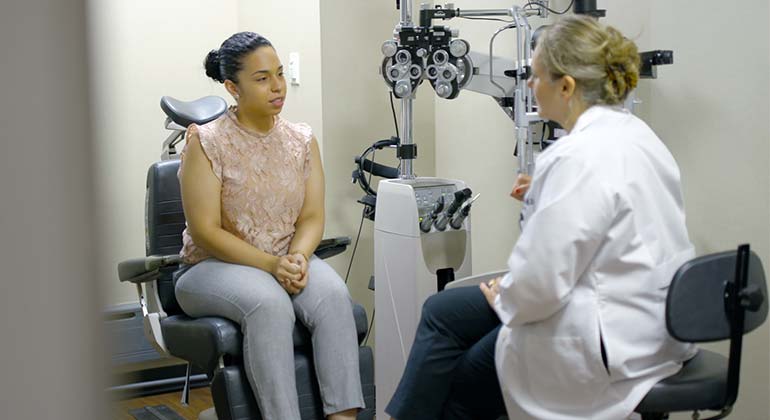Andalusia Eye Center: Premier Services for Vision Correction
Andalusia Eye Center: Premier Services for Vision Correction
Blog Article
The Benefits And Drawbacks of Different Refractive Surgical Procedures for Enhanced Eyecare

LASIK Surgery
LASIK surgical procedure is a typically performed refractive treatment that intends to correct vision problems such as astigmatism, farsightedness, and nearsightedness. This surgical method has actually obtained appeal as a result of its efficiency in giving clients with more clear vision and decreasing their reliance on glasses or get in touch with lenses. During the procedure, a thin flap is created on the cornea, and a laser is made use of to improve the underlying cells, correcting the refractive error. The flap is after that rearranged, enabling fast healing and marginal pain for the patient.
Among the main advantages of LASIK surgical treatment is the rapid improvement in vision experienced by several clients. A lot of individuals notice a substantial improvement in their vision soon after the treatment, with very little downtime required for recuperation. Furthermore, LASIK is understood for its high success price and reduced incidence of problems when performed by competent doctors. Nevertheless, like any surgery, LASIK additionally lugs some threats, consisting of dry eyes, glow, halos, and under or overcorrection of vision. It is crucial for individuals taking into consideration LASIK surgical treatment to undergo a thorough evaluation by an eye care specialist to identify if they are ideal prospects for the procedure.
PRK Procedure
The PRK treatment, additionally known as Photorefractive Keratectomy, is a type of refractive surgical treatment that aims to fix vision issues comparable to LASIK surgical procedure. Unlike LASIK, which entails developing a flap in the cornea, PRK functions on the surface layer of the cornea.
One of the advantages of PRK over LASIK is that it removes the risk of flap-related problems since no flap is developed during the surgical procedure. Regardless of the longer healing period, PRK can be an appropriate option for people looking for vision adjustment surgical procedure.
SMILE Surgical Treatment
A cutting-edge refractive surgical treatment method gaining popularity in the area of ophthalmology is SMILE Surgery. Tiny Cut Lenticule Removal (SMILE) is a minimally invasive treatment that corrects vision by reshaping the cornea making use of a femtosecond laser. Unlike standard LASIK surgical procedure, SMILE Surgery includes creating a little cut in the cornea to draw out a lenticule, which causes much less disturbance to the corneal structure and potentially much faster recuperation times.
One of the key advantages of SMILE Surgical treatment is its capacity to deal with myopia (nearsightedness) and astigmatism with high accuracy, bring about outstanding visual end results for patients. The minimally invasive nature of the procedure likewise minimizes the danger of difficulties such as dry eye syndrome, making it a beneficial choice for people seeking refractive surgical treatment.

LASEK Method
Having actually discovered the benefits and considerations of SMILE Surgery, one more noteworthy refractive surgery strategy worth examining is the LASEK Strategy. LASEK, which stands for Laser-Assisted Subepithelial Keratectomy, is a type of laser eye surgical treatment that aims to remedy refractive errors such as nearsightedness (nearsightedness), hyperopia (farsightedness), and astigmatism.
Unlike LASIK, LASEK does not entail developing a corneal flap. Rather, throughout a LASEK procedure, the specialist utilizes a diluted alcohol service to loosen the thin outer layer of the cornea, referred to as the epithelium. This layer is then gently relocated apart to allow the laser to improve the underlying corneal tissue. Once the cornea has actually been improved to the preferred degree, the epithelial layer is rearranged.
Among the key benefits of LASEK is that it can be appropriate for people with slim corneas who might not be excellent prospects for LASIK. Additionally, LASEK typically causes very little post-operative discomfort and a quicker recovery time contrasted to PRK. The aesthetic healing process with LASEK may be slightly longer than with LASIK.
Implantable Contact Lenses
Implantable Contact Lenses offer a lasting vision adjustment remedy for individuals seeking an alternative to typical contact lenses or glasses. These lenses, likewise recognized as phakic intraocular lenses, are surgically put into the eye to deal with refractive errors such as myopia (nearsightedness), hyperopia (farsightedness), and astigmatism. cardiologist andalusia. Unlike conventional call lenses that sit on the surface of the eye, implantable call lenses function within the eye itself, providing clear vision without the need for day-to-day upkeep or removal
One of the essential advantages of implantable call lenses is their durability. Once placed, they can stay in the eye forever, offering regular and secure vision correction. Furthermore, these lenses can be an outstanding alternative for people that are bad prospects for laser eye surgery or who choose a reversible vision modification treatment.
However, implantable contact lenses do carry some risks, including the potential for cataracts or increased eye pressure. It is important for people considering this choice to speak with an eye care specialist to establish if implantable call lenses are the appropriate selection for their certain needs and eye health and wellness.
Final Thought
To conclude, each type of refractive surgery has its very own advantages and disadvantages. LASIK surgical procedure is preferred for its fast healing time, while PRK procedure may be suitable for patients with slim corneas. SMILE surgical treatment provides very little discomfort during the treatment, however LASEK technique might have a longer healing process. Implantable contact lenses give a choice for those who are not appropriate candidates cardiologist andalusia for typical surgical procedures. Individuals should consult with their eye treatment supplier to figure out the very best option for their individual demands.

In General, SMILE Surgical procedure presents an appealing alternative for people looking to enhance their vision via refractive surgery.
Report this page